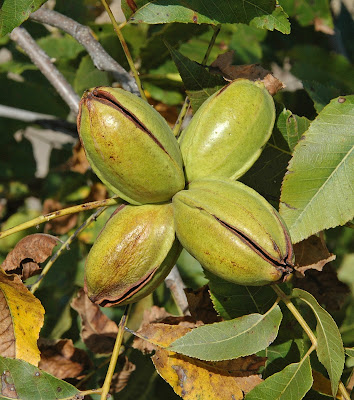All summer long I take mental notes on tree spacing within my orchard. This past summer, I noticed several areas in my pecan breeding block that were becoming crowded. Limbs of adjacent trees were nearly touching. Sunlight penetration into each and every tree canopy is critical for maximum nut production, so it was time to break out the chainsaw (photo above).
As you can see in the photo, I attach a couple of special implements on my tractor during the tree removal operation. On the tractor's front loader, I attach a hydraulic grapple to pick up the downed limbs and trunk. On the tractor's 3-point-hitch I've mounted a large tool box. The bottom of the tool box is lined with paving stones to provide sufficient weight to counter balance the pecan logs I lift with the grapple. Above the stones, I have plenty of room to carry 2 chainsaws, fuel, bar oil and tools for chainsaw maintenance.
When removing trees of this size (about 12 inches dbh), I always notch the trunk at a comfortable height so I can control the direction of tree fall. Once the tree is down, I'll cut the trunk off at ground level. Stump grinding comes later with a different implement and a different tractor.
This winter I also removed one of my problem trees. Tree number KT772 is a open pollinated seedling of Pawnee. As I young tree, I could forgive the scab susceptibility of this seedling (scabs about the same as Pawnee) because the nuts were large, thin-shelled, and good quality. However, like its Pawnee parent this tree started into alternate bearing at a fairly young age. In 2023, KT772 was the only tree in my orchard to set an excessive crop load. Note in the photo at left, all the limbs are drooping under the weight of nuts. By October, several limbs had snapped and fallen to the ground.
In previous years, KT772 ripened around October 7. However this year, the shucks on this tree never opened (photo at right) and were frozen tight on the nut shell following the 1st fall freeze.
Late in the fall I broke open a KT772 nut and found extremely poor kernel filling. Shuck split in pecan is promoted by plant growth regulators stimulated by fully formed kernels. Without proper kernel development, shuck split is either extremely late (like the drought year of 2022) or it will never happen.
Just before frost, I found that the shell of KT772 had only partially separated from the husk but the nut shell had developed its normal coloring. By the time I harvested my pecan crop, every KT772 nut was a blackened stick-tight (following 1st Fall freeze) and was totally worthless.
I have watched this tree long enough. So this winter KT772 was removed from my pecan breeding block.













































